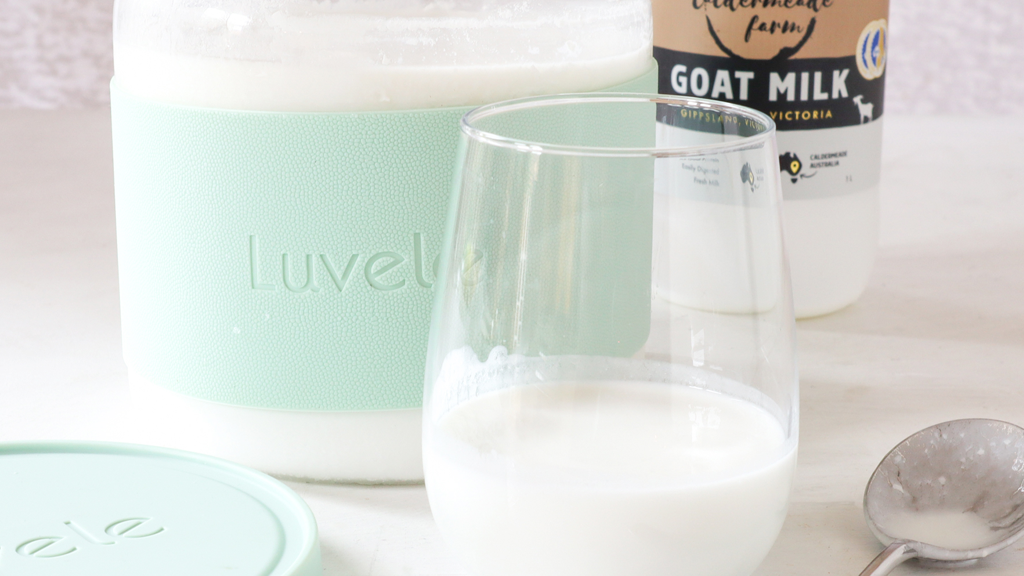Your Cart is Empty
Add description, images, menus and links to your mega menu
A column with no settings can be used as a spacer
Link to your collections, sales and even external links
Add up to five columns
Add description, images, menus and links to your mega menu
A column with no settings can be used as a spacer
Link to your collections, sales and even external links
Add up to five columns

Easy Goat Milk Kefir
Barb Hodgens
Barb Hodgens loves to cook with alternative, healthy whole food ingredients, with a focus on gut health. Barb has overcome her own gut health issues through healthy eating. Share your ideas, comments and photos at the end of this post :)

Tangy and packed with probiotics.
Kefir is a cultured dairy drink with deep roots in traditional fermentation and a reputation for delivering exceptional gut health benefits. It’s bursting with beneficial bacteria and yeasts and is known for its mild fizz, tart flavour, and impressive probiotic diversity. Plus, it's virtually lactose-free, so even people with lactose sensitivity can usually enjoy kefir without discomfort.
If you're new to kefir or looking for a simpler method, this recipe is for you. We’re using goat milk and the Cutting Edge Cultures Easy Kefir starterin the Luvele Yogurt Maker to make a batch that’s tangy and teeming with life - no kefir grains or fuss required!
Why goat milk?
The process for making kefir with goat milk is identical to using cow’s milk, but goat milk offers its own unique advantages. It’s often easier to digest, naturally lower in allergens, and rich in essential minerals like calcium, magnesium, and potassium.
Goat milk produces a thinner kefir with a distinctive, stronger flavour.

What is Easy Kefir?
Traditional kefir uses live ‘grains’, (gelatinous colonies of bacteria and yeast) to ferment milk. While effective, kefir grains require daily care and regular feeding, which doesn’t suit everyone.
Enter ‘Easy Kefir’ by Cutting Edge Cultures, a freeze-dried kefir starter that offers the same probiotic power without the maintenance. It behaves much like a yogurt starter culture and contains all the strains and yeasts found in traditional grains. The best part? No grains to handle, rinse, or store. Just culture, pour, and enjoy.
Make kefir in your Luvele Yogurt Maker
Kefir ferments best at around 25°C (78°F) and is usually made at room temperature in a glass jar. However, ambient temperatures vary widely and can result in unpredictable fermentation. Cooler weather may take several days, while warmer climates can over-ferment and turn your kefir sharp and sour.
The Luvele Yogurt Makers solve this problem by offering a precise temperature range from 25°C to 50°C (78°F to 122°F), ideal for fermenting not only yogurt but kefir and other cultured foods as well.
If you’ve been curious about trying kefir but put off by the idea of maintaining grains, Easy Kefir is a game-changer. Pair it with the precision of the Luvele Yogurt Maker, and you'll be sipping on probiotic-rich, gut-loving goat milk kefir in no time.

Kefir vs Yogurt – what’s the difference?
While both are cultured dairy products, kefir and yogurt differ in key ways:
Probiotic diversity: Yogurt typically contains 3–7 strains of beneficial bacteria. Kefir boasts 30–50 strains, including beneficial yeasts.
Potency: Kefir is considered more powerful in supporting gut health. Easy Kefir contains over 3 billion live bacteria and more than 50,000 lactic yeasts per gram.
Ease of preparation: Yogurt requires milk to be heated and held at specific temperatures. Kefir can be made using cold milk straight from the fridge—no heating needed.
Texture: Kefir is thinner and often slightly effervescent due to the active yeasts.
Reculturing Easy Kefir
Even though Easy Kefir doesn’t produce grains, it’s still possible to re-culture a new batch from your finished kefir. Simply reserve half a cup of this kefir, add it to fresh milk, then incubate in the yogurt maker again. When your batch is too sour, or doesn't thicken as before, it's time to start over with an Easy Kefir packet.
How to thicken goat milk kefir
Prefer a thicker consistency? You can easily strain your kefir through a muslin cloth, nut milk bag, or fine mesh strainer following this method. Straining removes some of the liquid (whey), leaving you with a richer, creamier kefir, similar to yogurt in texture.
Don’t throw away the whey! Store it in a glass jar in the fridge, it’s choke full of enzymes and beneficial bacteria. See this post for the many uses for whey.


Easy Goat Milk Kefir
Luvele
Rated 5.0 stars by 1 users
Pair Easy Kefir with the precision of the Luvele Yogurt Maker, and you'll be sipping on probiotic-rich, gut-loving goat milk kefir in no time.
Ingredients
- 2 litre (2.1 qt) goat milk
- 1 packet of Easy Kefir
Directions
- Thoroughly rinse your yogurt making glass jar and whisk with boiling water.
- Pour the goat milk into the yogurt making glass jar.
- Pour the Easy Kefir starter into the milk and stir thoroughly with a whisk to incorporate.
- Place the lid firmly on the glass yogurt jar and place into your yogurt maker. Pour water slowly into the base. (The water must not be filled over the ‘tall line’ indicated on the inside wall of the maker). Then place the cover lid on top.
- Use the digital control panel to set the temperature to 25°C/78°F and the time to 24-hours, then press ‘confirm’ to begin incubation.
- At the end of the fermentation, turn the yogurt maker off. Remove the cover lid and gently lift out the glass jar. Straight from the yogurt maker, the kefir will be warm. Place the jar in the fridge for at least 6 hours or overnight. When you put the kefir in the fridge the fermentation process continues but chilling it will slow down the fermentation of the healthy bacteria and beneficial yeast.
Recipe Video


PIN THIS RECIPE


Easy Goat Milk Kefir

Tangy and packed with probiotics.
Kefir is a cultured dairy drink with deep roots in traditional fermentation and a reputation for delivering exceptional gut health benefits. It’s bursting with beneficial bacteria and yeasts and is known for its mild fizz, tart flavour, and impressive probiotic diversity. Plus, it's virtually lactose-free, so even people with lactose sensitivity can usually enjoy kefir without discomfort.
If you're new to kefir or looking for a simpler method, this recipe is for you. We’re using goat milk and the Cutting Edge Cultures Easy Kefir starterin the Luvele Yogurt Maker to make a batch that’s tangy and teeming with life - no kefir grains or fuss required!
Why goat milk?
The process for making kefir with goat milk is identical to using cow’s milk, but goat milk offers its own unique advantages. It’s often easier to digest, naturally lower in allergens, and rich in essential minerals like calcium, magnesium, and potassium.
Goat milk produces a thinner kefir with a distinctive, stronger flavour.

What is Easy Kefir?
Traditional kefir uses live ‘grains’, (gelatinous colonies of bacteria and yeast) to ferment milk. While effective, kefir grains require daily care and regular feeding, which doesn’t suit everyone.
Enter ‘Easy Kefir’ by Cutting Edge Cultures, a freeze-dried kefir starter that offers the same probiotic power without the maintenance. It behaves much like a yogurt starter culture and contains all the strains and yeasts found in traditional grains. The best part? No grains to handle, rinse, or store. Just culture, pour, and enjoy.
Make kefir in your Luvele Yogurt Maker
Kefir ferments best at around 25°C (78°F) and is usually made at room temperature in a glass jar. However, ambient temperatures vary widely and can result in unpredictable fermentation. Cooler weather may take several days, while warmer climates can over-ferment and turn your kefir sharp and sour.
The Luvele Yogurt Makers solve this problem by offering a precise temperature range from 25°C to 50°C (78°F to 122°F), ideal for fermenting not only yogurt but kefir and other cultured foods as well.
If you’ve been curious about trying kefir but put off by the idea of maintaining grains, Easy Kefir is a game-changer. Pair it with the precision of the Luvele Yogurt Maker, and you'll be sipping on probiotic-rich, gut-loving goat milk kefir in no time.

Kefir vs Yogurt – what’s the difference?
While both are cultured dairy products, kefir and yogurt differ in key ways:
Probiotic diversity: Yogurt typically contains 3–7 strains of beneficial bacteria. Kefir boasts 30–50 strains, including beneficial yeasts.
Potency: Kefir is considered more powerful in supporting gut health. Easy Kefir contains over 3 billion live bacteria and more than 50,000 lactic yeasts per gram.
Ease of preparation: Yogurt requires milk to be heated and held at specific temperatures. Kefir can be made using cold milk straight from the fridge—no heating needed.
Texture: Kefir is thinner and often slightly effervescent due to the active yeasts.
Reculturing Easy Kefir
Even though Easy Kefir doesn’t produce grains, it’s still possible to re-culture a new batch from your finished kefir. Simply reserve half a cup of this kefir, add it to fresh milk, then incubate in the yogurt maker again. When your batch is too sour, or doesn't thicken as before, it's time to start over with an Easy Kefir packet.
How to thicken goat milk kefir
Prefer a thicker consistency? You can easily strain your kefir through a muslin cloth, nut milk bag, or fine mesh strainer following this method. Straining removes some of the liquid (whey), leaving you with a richer, creamier kefir, similar to yogurt in texture.
Don’t throw away the whey! Store it in a glass jar in the fridge, it’s choke full of enzymes and beneficial bacteria. See this post for the many uses for whey.

:recipekit:


PIN THIS RECIPE


Subscribe
Sign up to get weekly healthy recipes & information on new product releases.
Item is added to cart


